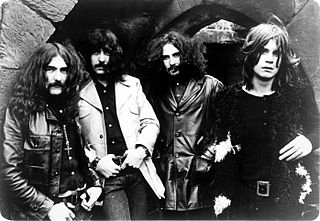
Black Sabbath were an English rock band formed in Birmingham in 1968 by guitarist Tony Iommi, drummer Bill Ward, bassist Geezer Butler and vocalist Ozzy Osbourne. They are often cited as pioneers of heavy metal music. The band helped define the genre with their first three albums Black Sabbath, Paranoid and Master of Reality (1971). Following Osbourne's departure in 1979, the band underwent multiple line-up changes, with Iommi being the only constant member throughout their history.

Paranoid is the second studio album by English heavy metal band Black Sabbath, released on 18 September 1970 by Vertigo Records in the United Kingdom and on 7 January 1971 by Warner Bros. Records in the United States. The album contains several of the band's signature songs, including "Iron Man", "War Pigs" and the title track, which was the band's only Top 20 hit, reaching number 4 on the UK charts.

Never Say Die! is the eighth studio album by English rock band Black Sabbath, released on 29 September 1978. It was the last studio album with the band's original lineup and the last studio album to feature original vocalist Ozzy Osbourne until the 2013 album 13. It was certified Gold in the U.S. on 7 November 1997 and as of November 2011 has sold 133,000 copies in the United States since the SoundScan era. The album received mixed reviews, with critics calling it "unbalanced" and insisting its energy was scattered in too many directions.
"War Pigs" is an anti-war protest song by English heavy metal band Black Sabbath, released in 1970. It is the opening track from the band's second studio album Paranoid (1970).
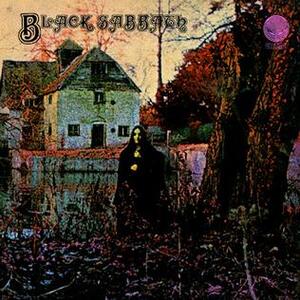
Black Sabbath is the debut studio album by English heavy metal band Black Sabbath, released on 13 February 1970 by Vertigo Records in the United Kingdom and on 1 June 1970 by Warner Bros. Records in the United States. The album is widely regarded as the first true heavy metal album, and the opening track, "Black Sabbath", has been referred to as the first doom metal song.

Anthony Frank Iommi Jr. is an English musician. He co-founded the pioneering heavy metal band Black Sabbath, and was the band's guitarist, leader, primary composer, and sole continuous member for over five decades. He is considered one of the trailblazers and pioneers of heavy metal music, and is responsible for inspiring numerous subgenres of metal, most notably doom metal. Iommi was ranked number 13 on Rolling Stone's 2023 list of the “250 Greatest Guitarists of all Time.

Sabotage is the sixth studio album by English heavy metal band Black Sabbath, released on 28 July 1975. The album was recorded in the midst of a legal battle with the band's former manager, Patrick Meehan. The stress that resulted from the band's ongoing legal woes infiltrated the recording process, inspiring the album's title. It was co-produced by guitarist Tony Iommi and Mike Butcher.
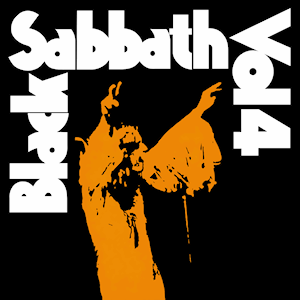
Vol. 4 is the fourth studio album by English heavy metal band Black Sabbath, released in September 1972. It was the first album by Black Sabbath not produced by Rodger Bain; guitarist Tony Iommi assumed production duties. Patrick Meehan, the band's then-manager, was listed as co-producer, though his actual involvement in the album's production was minimal.

We Sold Our Soul for Rock 'n' Roll is a compilation album by British heavy metal band Black Sabbath, originally released in January 1976 in the UK and 3 February 1976 in the US.
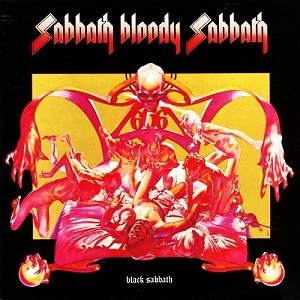
Sabbath Bloody Sabbath is the fifth studio album by English heavy metal band Black Sabbath, released in November 1973. It was produced by the band and recorded at Morgan Studios in London in September 1973. The writing process for the album, which began in Los Angeles, California, was initially hampered in part by the band's substance abuse and fatigue following their 1972–1973 world tour in support of their previous album, Vol. 4. The band then relocated to Clearwell Castle in the Forest of Dean, Gloucestershire, England, where guitarist Tony Iommi conceived the main riff of what became the album's title track and lead single.

Heaven and Hell is the ninth studio album by English heavy metal band Black Sabbath, released on 18 April 1980. It is the first Black Sabbath album to feature vocalist Ronnie James Dio, who replaced original vocalist Ozzy Osbourne in 1979.

"Iron Man" is a song by English heavy metal band Black Sabbath, released in 1970 from the band's second studio album, Paranoid, and as a single in the US in October 1971.

Reunion is a live album by English heavy metal band Black Sabbath, released on 19 October 1998. As implied by the title, the album features a reunion of the original Black Sabbath lineup of vocalist Ozzy Osbourne, guitarist Tony Iommi, bassist Geezer Butler and drummer Bill Ward. The album represents the first new release featuring that version of the group since 1978's Never Say Die! and Osbourne's subsequent firing the following year. Black Sabbath received their first ever Grammy Award in 2000 for the live recording of "Iron Man" taken from Reunion.
"Sweet Leaf" is a song by English heavy metal band Black Sabbath from their third studio album Master of Reality (1971), released on July 21, 1971. It is considered one of the band's best songs and was included on their 1976 greatest hits compilation We Sold Our Soul for Rock 'n' Roll.

Past Lives is a live album released in 2002 by Black Sabbath. It peaked at number 114 on the Billboard 200. The first disc was previously known as Live at Last, an album not put out by Black Sabbath's record company, and therefore not an official Black Sabbath album. The second consists of recordings made for television and radio, previously only available on bootlegs. It was released as a digipak and later a standard jewel-case.
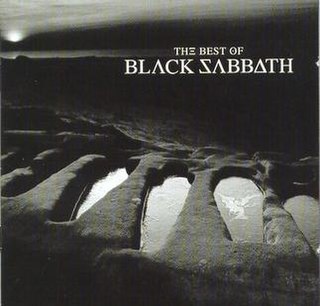
The Best of Black Sabbath is a double CD compilation album by Black Sabbath released in 2000 on the Sanctuary Records label. Its 32 songs are presented chronologically from the band's first 11 albums, spanning the years 1970 to 1983. Black Sabbath's classic six-album run, from 1970s debut Black Sabbath through 1975's Sabotage is celebrated with three to six songs from each album. Original vocalist Ozzy Osbourne's subsequent final two albums with the band, 1976's Technical Ecstasy and 1978's Never Say Die!, are represented by one and two songs, respectively. Replacement Ronnie James Dio's early 80's stint fronting the band on two albums is acknowledged with the title track of 1980's Heaven and Hell and a track from 1981's The Mob Rules. The compilation closes with a song from 1983's attempted rebirth, Born Again, former Deep Purple vocalist Ian Gillan's sole album with the band. The Best of Black Sabbath does not include any later material with vocalists Glenn Hughes, Tony Martin (1986–96) or the returning Dio.

Greatest Hits 1970–1978 is a compilation album from Black Sabbath, released in 2006.

The Collection is a compilation album released by English heavy metal band Black Sabbath in 1992. The album was released on the label Castle, who released two CD versions of this album in the UK, both with the same cover art and songs. The album includes greatest songs of Black Sabbath with Ozzy Osbourne prior to his dismissal in 1979, from the eponymous album to Never Say Die!. The album has 15 tracks, two from Black Sabbath, two from Paranoid, one from Master of Reality, two from Black Sabbath Vol. 4, two from Sabbath Bloody Sabbath, two from Sabotage, two from Technical Ecstasy and two from Never Say Die!.
"Solitude" is a song by the English heavy metal band Black Sabbath. It was originally released as the seventh track off their 1971 album Master of Reality, and later as the B-side to the single, "Children of the Grave".

Black Sabbath: The End of the End is a 2017 concert documentary film about English heavy metal band Black Sabbath, performing the final show of their farewell concert tour, known as The End Tour. The performance took place at the Genting Arena in Birmingham, England, on 4 February 2017, and features founding Black Sabbath members Ozzy Osbourne, Tony Iommi and Geezer Butler, with session drummer Tommy Clufetos filling in for the band's original drummer, Bill Ward. The film also features footage of "The Angelic Sessions"—the band's final studio recordings, recorded in the days following the final show.


















